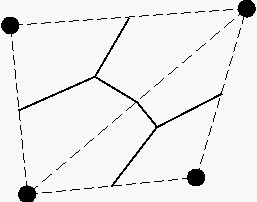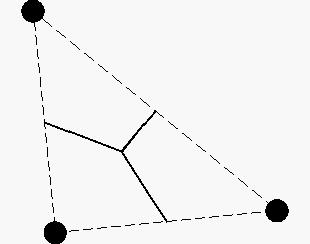Numeric Scheme
Flowmesh adopts a suitable mixture of mesh deformation, edge-swapping and node insertion/deletion techniques to adapt the grid to the solution and to the position of the boundaries. A modified version of the ALE formulation is implemented, such that no interpolation is necessary to obtain the solution over the new grid.
Numeric Scheme
The goal of the Flowmesh project is to develop a novel CFD tool for simulating the complex flow field around rotorcrafts. Two main design requirements are to be fulfilled. First, the new tool is to be capable of dealing with complex, non-standard, geometries without or with limited user intervention. Secondly, high efficiency, in terms of both computational time and memory requirements, is mandatory. The possibility of performing simulations using a large number of grid elements is key to the possibility of capturing local flow features, such as vortical structures and shock waves, that are of paramount importance in the computation of e.g. acoustic emissions. In this respect, the use of unstructured adaptive grid is envisaged to cluster grid nodes in the regions of interests.
A mesh adaptation technique is usually required to follow the boundaries movements, to avoid an excessive stretching of the element, to reduce the loss of quality of the unstructured mesh and to preserve the initial spacing. Moreover it is mandatory to conveniently gather the grid nodes in regions of interest within the aerodynamic field. For example such feature is crucial for describing the vortices shed by the blades, or of the shock wave on the blades tips, where the locally increase in the spatial resolution, thus of the solution accuracy, results in a reduction of the numerical diffusion of the vorticity.
Flowmesh performs the grid adaptation resorting to two different techniques: a the grid deformation method based on the continuum analogy and local topology modifications (edge swapping, face swapping, node insertion, node deletion and local re-mesh). With a suitable mixture of this components large displacement of the boundaries can be performed obtaining a new geometry-conformal grid which is characterized by a high quality level.
The compressible Euler equations are solved by means of a Finite-Volumes, node centered, TVD approach. The solver is also edge-based, so all computations are performed only over the edges of the mesh. Governing equations are discretized in time by means of BDF implicit schemes that and integrated with a dual time-stepping technique in order to overcome to the limitation imposed by the CFL condition [8]. The implementation of the finite volume scheme described above is straightforward and very efficient [7].
The main novelty of the approach is the interpretation of the mesh modifications, due to adaptation, as a continuous deformation of the finite volumes associated to the grid. In the MOVIES A, B and C the reinterpretations for two dimensional edge swapping and node insertion/deletion are reported. The introduction of the ALE (Arbitrary Lagrangian-Eulerian) formulation of the governing equations therefore allows to perform computations on moving meshes without any interpolation step. The satisfaction of additional consistency conditions on the interfaces velocities is however required; note that this is also an easy way to automatically fulfill the well known GCL constrain. The extension of such approach to techniques that modify the topology of the grid (e.g. edge-swapping) allows to compute the solution on a new time level, i.e. on a topologically different grid, by directly integrating the governing equations.


